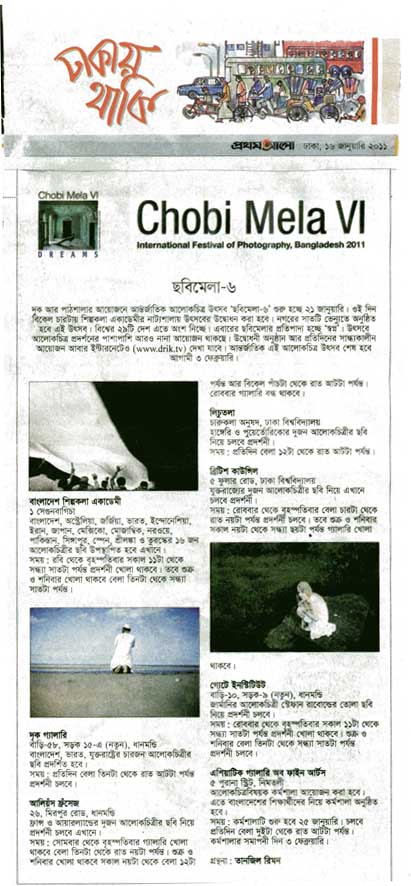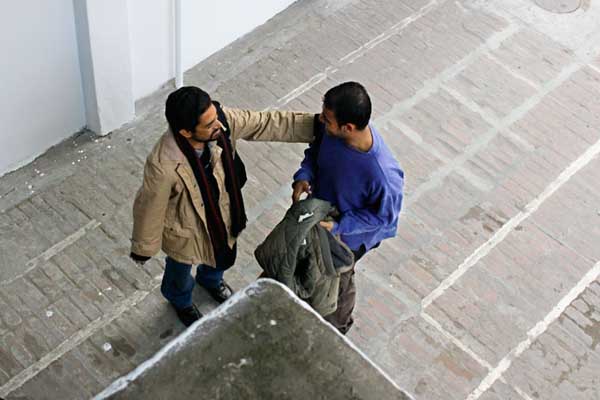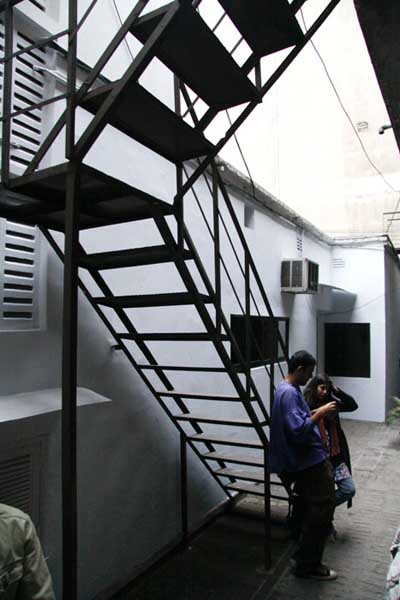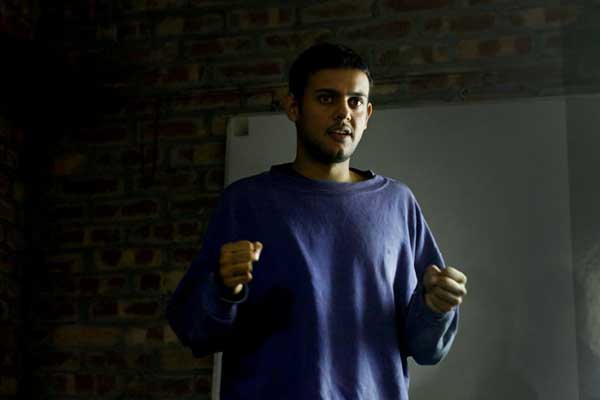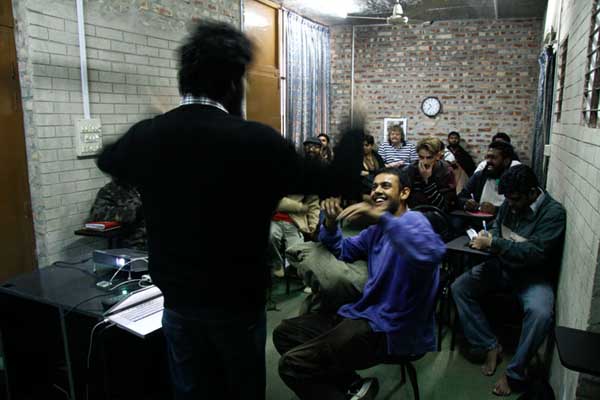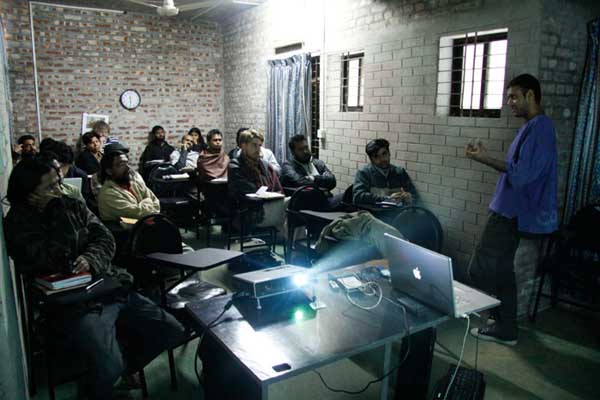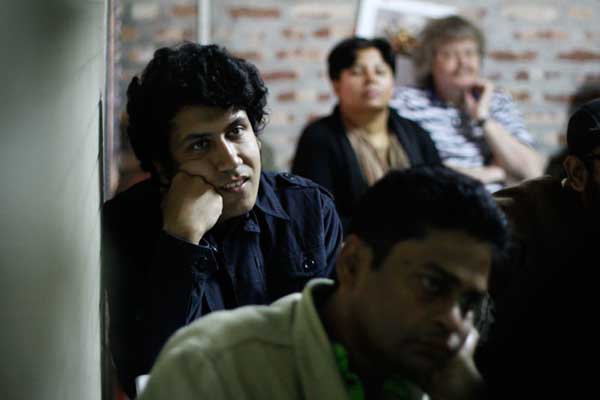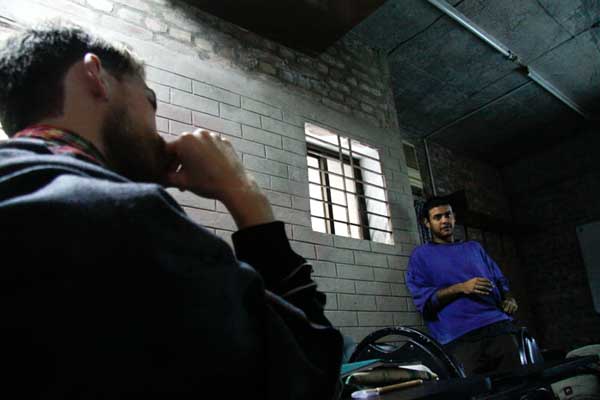Tag: media
Chobi Mela VI on Wall Street Journal
Subscribe to ShahidulNews
![]()
JANUARY 19, 2011, 10:03 AM IST
Festival Puts Bangladesh on Photography Map
By Margherita Stancati
When one of Asia?s largest photography festivals, Chobi Mela, kicks off on Friday, it is expected to draw photographers from over 30 countries to a show that has turned an unlikely destination into an important stop on the international photography circuit over the last decade.
Photographers, many of whom are photojournalists, will be showcasing their work in multiple venues ? including on mobile rickshaw vans ? across Bangladesh?s capital city Dhaka for this year?s edition of the two-week festival.
Chobi Mela founder and director Shahidul Alam said the original idea behind the festival was to provide a platform for South Asian photographers to display their work and to connect with a global audience.
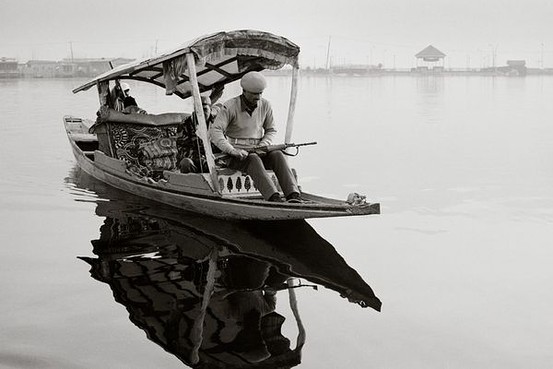
Mr. Alam said the festival is also about challenging the prevailing narrative on the history of photography, which he criticizes as heavily ?eurocentric.? Despite South Asia?s long-standing and vibrant photography scene, Mr. Alam said, ?It looks as though photography practice only happened in the West.?
Since it first started in 2000, the festival has grown in scope and size attracting internationally-acclaimed photographers and drawing around 200,000 visitors in recent years, according to figures provided by festival organizers.
This year?s theme??Dreams??may seem an odd choice for a festival known for photojournalism, which often captures harsh realities. Mr. Alam says there is no contradiction, pointing to the social vision that photography can convey.
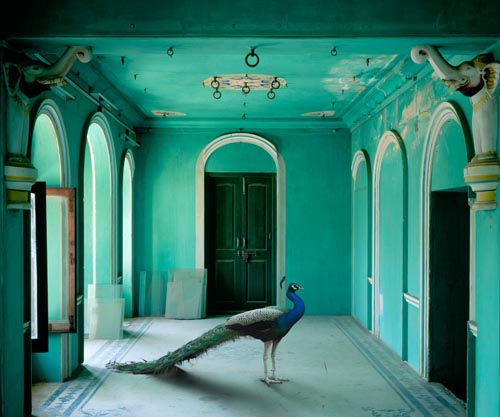
Many of the artists who will be displaying their work at Chobi Mela?such as Britain?s Joanna Petrie and Karen Knorr, who?ll be showing works from her India Song series?frame dreams as conceptual fantasies. Others, including Dhaka-based Sayed Asif Mahmud and Spain?s Aitor Lara, capture them more as impressions of reality.
Many emerging talents from South Asia will be showcasing their work at this year?s edition, the festival?s sixth, including Bangladesh?s Munem Wasif and India?s Amit Mehra.
But Mr. Alam said Chobi Mela is not just about displaying works of art ? it?s also about creating a forum for photographers to engage in critical debate on the social role of their work.
With that in mind, running parallel to the 29 print exhibitions are a series of talks that include a video conference with International Criminal Court Prosecutor Luis Moreno-Ocampo. He is likely to address the role of photography in influencing public opinion on war crimes such as those allegedly committed during Bangladesh?s war of independence in 1971. A tribunal to try war crimes was set up in Bangladesh last year.
The violent struggle that led to the country?s independence from Pakistan in 1971 has been a running theme at Chobi Mela ? and the focus of its first edition.
?Not only was it so central to our existence, but the who?s who of photojournalism were in Bangladesh at the time,? said Mr. Alam.
Among them were French photographer Raymond Depardon, British photojournalist Don McCullin and American photographers like Mary Ellen Mark, and David Burnett, whose more recent work on Iran will be on display in Dhaka this year.
If you can?t be in Dhaka this weekend, you can still see the works that will be exhibited there through live streaming. And after Chobi Mela ends, the show will tour South Asia. Dates haven?t been set yet, but it?s expected to reach India in the fall.
Slideshow: A preview of Bangladesh?s Photo Festival.
Chobi Mela VI on Prothom Alo
Subscribe to ShahidulNews
Prothom Alo is the largest circulation daily in Bangladesh
16th January 2011
Chobi Mela VI workshops begin
Subscribe to ShahidulNews

Indian photographer Sohrab Hura is conducting a workshop ?Untitled? with the 2nd year student?s of Pathshala. The workshop theme for everyone is CARTE BLANCHE, which means everyone is free to do whatever s/he wants. It will continue till 21st January 2011.
Photographs by K M Asad
Media and Mobs
Subscribe to ShahidulNews
By Arundhati Roy
Monday, November 01, 2010
(Courtesy: Znet)
New Delhi, October 31: A mob of about a hundred people arrived at my house at 11 this morning (Sunday October 31st 2010.) They broke through the gate and vandalized property. They shouted slogans against me for my views on Kashmir, and threatened to teach me a lesson.
The OB Vans of NDTV, Times Now and News 24 were already in place ostensibly to cover the event live. TV reports say that the mob consisted largely of members of the BJP?s Mahila Morcha (Women?s wing).
After they left, the police advised us to let them know if in future we saw any OB vans hanging around the neighborhood because they said that was an indication that a mob was on its way. In June this year, after a false report in the papers by Press Trust of India (PTI) two men on motorcycles tried to stone the windows of my home. They too were accompanied by TV cameramen.
What is the nature of the agreement between these sections of the media and mobs and criminals in search of spectacle? Does the media which positions itself at the ?scene? in advance have a guarantee that the attacks and demonstrations will be non-violent? What happens if there is criminal trespass (as there was today) or even something worse? Does the media then become accessory to the crime?
This question is important, given that some TV channels and newspapers are in the process of brazenly inciting mob anger against me.
In the race for sensationalism the line between reporting news and manufacturing news is becoming blurred. So what if a few people have to be sacrificed at the altar of TRP ratings?
The Government has indicated that it does not intend to go ahead with the charges of sedition against me and the other speakers at a recent seminar on Azadi for Kashmir. So the task of punishing me for my views seems to have been taken on by right wing storm troopers.
The Bajrang Dal and the RSS have openly announced that they are going to ?fix? me with all the means at their disposal including filing cases against me all over the country. The whole country has seen what they are capable of doing, the extent to which they are capable of going.
So, while the Government is showing a degree of maturity, are sections of the media and the infrastructure of democracy being rented out to those who believe in mob justice?
I can understand that the BJP’s Mahila Morcha is using me to distract attention from the senior RSS activist Indresh Kumar who has recently been named in the CBI charge-sheet for the bomb blast in Ajmer Sharif in which several people were killed and many injured.
But why are sections of the mainstream media doing the same?
Is a writer with unpopular views more dangerous than a suspect in a bomb blast? Or is it a question of ideological alignment?
Arundhati Roy
October 31st 2010
Murdoch phone hacking scandal
Subscribe to ShahidulNews
Murdoch phone hacking scandal engulfs all Britain?s major parties
By Jean Shaoul
22 September 2010
World Socialist Website
A desperate damage control operation is underway as further allegations emerge about the extent of the illegal phone hacking at the Rupert Murdoch-owned?News of the World. The paper?s royal editor and a private investigator were found guilty of hacking into the voice mail of members of the Royal family and their aides in 2007.
It is now alleged that the practice was much more prevalent than was revealed at the time and that the Metropolitan Police failed to investigate all the cases known to them.
Journalist Clive Goodman and private investigator Glenn Mulcaire were found guilty at the Old Bailey in January 2007 after they admitted hacking into phones. Goodman was jailed for four months and Mulcaire for six months.News of the World editor Andy Coulson resigned following the case. He denied knowing about the hacking, but he accepted ultimate responsibility as editor of the paper. Prime Minister Gordon Brown immediately phoned to offer his commiserations. He assured the journalist that he had acted honourably in resigning and expressed his confidence that Coulson would soon have another job.
Coulson is now Prime Minister David Cameron?s director of communications and at the centre of the new allegations. His presence in the new Conservative/Liberal Democrat coalition administration implicates all three major political parties in the affair. It is now suggested that under the previous Labour government, the police and parliamentary investigations were cut short. The Liberal Democrats, who challenged Coulson?s claims that he was ignorant of the phone hacking, are now part of an administration in which Coulson plays a key role and must, as deputy Prime Minister Nick Clegg did in the House of Commons earlier this month, defend him.
A network of relationships has been exposed which reveal the incestuous nature of the British political elite and its ties to global corporate interests, in particular to Rupert Murdoch?s News International Corporation. A coalition government has just come to power that supposedly represents a new chapter in British political life after 13 years of Labour rule. But the Murdoch empire has slipped seamlessly from one government to the next. Even if Coulson is never charged with any crime and never found guilty of any crime, this affair will have demonstrated beyond a shadow of doubt that official politics in Britain is entirely divorced from the interests of ordinary people and in the hands of a criminal oligarchy who act outside the law.
Real political power lies with this plutocratic layer and not with elected representatives in Parliament. Allegations have emerged this month that the House of Commons Culture, Media and Sport Committee held back from pursuing its investigation into phone hacking at the?News of the World. Adam Price, a former Plaid Cymru MP who retired from Parliament in May, claims that MPs were afraid that their private lives would come under investigation if they called on News International Chief Executive Rebekah Brooks to testify. Members of the committee discussed getting the sergeant-at-arms to issue a subpoena for Mrs. Brooks.
Continue reading “Murdoch phone hacking scandal”
Flotilla Fabrication
Subscribe to ShahidulNews
![]()
?The average person believes implicitly that the photograph cannot falsify. Of course, you and I know that this unbounded faith in the integrity of the photograph is often rudely shaken, for, while photographs may not lie, liars may photograph.?
Lewis Hine 1909
Photographers often get defensive when reminded that many of them resort to ?digital manipulation? using the new tools currently available. Discussions about the limits of what is permissible regularly sparks off heated debates, particularly in contests. Jobs have been lost, awards cancelled, and credibility undermined when photographers have digitally manipulated photographs to create the image they have wanted.
Sadly, the arguments raised have largely dealt with issues of technique rather than issues of ethics. One school of thought suggests, ?if it was doable in a darkroom, then it can be doable in a computer?. Others claim that conventional darkroom techniques, such as dodging, burning, or changing contrast are acceptable, but inserting, taking away, or displacing visual elements are off limits (though these too were, and had been, done in the darkroom). More ?artistic? criteria suggest that the essential ?mood and character? of the original image must be preserved. None of this addresses the central issue Hine had brought up in 1909. Is the photographer lying?
I believe the discussion needs to shift from ?how? the image was altered to ?why? it was altered. Indeed, photographers have ?enhanced? their images by using filters to darken skies, dodged and burned in the darkroom to change relative emphasis of visual elements, sometimes even eliminated visuals that distracted from what was considered central to the photograph. Subtle changes in tonality and gradation altered the ?feel? of an image, affecting the emotional response one might have to the visual experience.? In the analogue days, the skill sets required hand-eye? coordination to a far greater extent than is needed today. The modern photographer needs to learn about pixels, paths and plug-ins. The software used, the amount of RAM and processor speed are the new vocabulary that replaces darkroom tools of yore. But even in the digital age, the skill of the practitioner often determines whether the change is detectable.
There are those who subvert the process and deliberately play on detectability of the process, confronting the viewer with their interventions, questioning her perception of what is acceptable, stretching her boundaries of credibility. Indeed, on occasions, flaunting these very norms to raise uncomfortable issues of how images are read. Early theorists like Professor Fred Ritchin, currently at Tisch School of The Arts, New York University, have eloquently analysed how this ?manipulation?, instead of undermining the credibility of the photograph, has returned the onus of authenticity upon the integrity of the author rather than the acceptability of the tools (human or mechanical).? One believes a photograph, as one believes a word, based on the reliability of the source, rather than the mode of production. The hugely talented pioneer of digital photography, the Mexican photographer Pedro Meyer, playfully, intelligently and skillfully, toyed with us, shaking the pillars of our age old beliefs, forcing us to question the process of seeing and believing.
Of course the photograph still retains the characteristic of being the primary source. ?I was there. I saw it with my own eyes. I have photographs.? It is precisely because the photograph or the video, is seen as an unmoderated fact, that it is so powerful. It is precisely the reason why lying through a video or photograph can be so effective.
In this age of spin, rhetoric and hyperbole, does the liar, by shaking our confidence in the medium, undermine the veracity of the one source that we still implicitly trust? In some ways of course it does, but by doing so, the liar does us a favour. It reminds us to question, not merely the medium but also the source.
Buddha, Moses, Jesus and Mohammed were believed because they were trustworthy. They had established their credibility. They had a track record that gave their word a respectability that others who said otherwise did not have. I have no way to vouch for the veracity of the incredible claims that they made. That is the basis of a very different discussion. But it is undeniably true that centuries after they have gone, there are people who live by their ideals and are prepared to die for them. The lives that they lived, made their words believable. We believed their actions, which led to us believing their words.
That brings me to the point of this article. The video of the attack on the flotilla. People have correctly pointed to the technical errors in the released videos. The fact that there were white frames inside the sequence, that consecutive frames did not match, that crude alterations revealed the manipulation where people are seen to be walking through metal pylons, the amateurish display of a catapult by turning towards a camera on a tripod and holding it high, in the middle of an attack by armed soldiers, the fact that a voice inserted in the video is that of a woman on another ship, all make the video a laughable piece of ?evidence?. Indeed, the detection of the tampering is what is being used as evidence of lies being told.
My argument is elsewhere. What if the Israelis had produced the perfect video, backing up their claims. What if their technicians had been more skilled, their computer animations more realistic, their actors more adept and telling their version of the story. Would that have validated their version of the story? I would like to return to who is telling the story. The veracity of the source.
Lies are more difficult to protect than the truth. If the version they had presented had been genuine, there would have been no need to confiscate all the visual material, releasing selective segments, with obvious tampering. If they had nothing to hide there would have been no need to jam the communications at the moment of attack, or to erase the audio from certain segments of the video. There would have been no reluctance to make all the evidence available and let the viewers decide. Suspicious behavior gives rise to suspicion. For a nation known for manipulating the truth at all levels, casting doubts on authentic data, vilifying honest citizens, persecuting every hint of dissent, it is the fact that the source is Israel that is the greatest reason for disbelief.
If a time were to come when Israel had a change of heart and for once spoke the truth, like Matilda in her burning house, there would be none to believe her. That fire is imminent and Israel?s house of lies might well be close to burning.
———————ENDS————————–
Other points of view.
BBC Panorama Video 1
BBC Panorama Video 2
“>Al Jazeera Storming of Gaza aid convoy
Legal assessment of Gaza Flotialla raid
Related links:
Military ties between India and Israel
In Defense of Helen Thomas
Human Rights Council Condemnation of Israeli Attacks
Adopted by a recorded vote of 32 to 3, with 9 abstentions.
The voting was as follows:
In favour: Angola, Argentina, Bahrain, Bangladesh, Bolivia, Bosnia and Herzegovina, Brazil, Chile, China, Cuba, Djibouti, Egypt, Gabon, Ghana, India, Indonesia, Jordan, Kyrgyzstan, Mauritius, Mexico, Nicaragua, Nigeria, Norway, Pakistan, Philippines, Qatar, Russian Federation, Saudia Arabia, Senegal, Slovenia, South Africa, Uruguay;
Against: Italy, Netherlands, United States of America;
Abstaining: Belgium, Burkina Faso, France, Hungary, Japan, Republic of Korea, Slovakia, Ukraine, United Kingdom of Great Britain and Northern Ireland:
Journo Jaunts
Subscribe to ShahidulNews
By Pedro Naik
Ye olde paper is really losing its marbles. How else to explain the call I received from the editor? ?Pedro,? he barked, nearly blowing my head off as I put the receiver to my ear, ?stop all this frippery-trippery stuff right now! I want you to write stories for our business section. Your first assignment is on garbage.?
?But that?s an environment and civic issues story,? I protested. He was having none of it. ?Garbage is big business now ? the biggest in fact,? he retorted. ?Now get going.? So there I was, trying to make a story out of garbage rather than vice-versa, as is my usual practice. But how? The rubbish czar doesn?t give interviews. And then I remembered. In keeping with the visionary moves Goan business has been making of late, discredited yellow journos are being provided employment as corporate mouthpieces, providing a ray of hope for the future to hacks like me, who are fast approaching their sell-by date.
So there I was, at the gates of the mega-corporation, rather curiously named the Fermento Group. As I entered the plush office of the aforementioned journo-turned-corporate-shill, I was mystified to see the place done up like a faux Goan taverna, amidst which a Billy Bunterish figure sat on a reclining chair, sipping from a glass. Approaching him, I saw that he was dressed in a hideous flowered shirt and Bermudas, topped by a straw hat, looking like a bhaiyya tourist drawn by Mario Miranda on a bad day.
?Drinking at 10 am? And what?s with the costume? Off to the beach?? I asked. ?That?s how true Goans do it,? the fount of wisdom on all things truly Goan informed me. I made a mental note to change my trousers and shirt for something more in keeping with my ethnic background, and also to tone up on my feni drinking while I?m about it. ?Anyway,? he continued, ?let?s work on your story on garbage. And no defamatory stuff like you chappies have been writing.?
?But we only said that an experienced NGO doing things at a low cost was unceremoniously discarded for an overpriced proposal by a corporate group without any experience in the field, jobs for the boys and all that,? I protested. The corporate flunkey went red in the face. ?That?s entirely the wrong angle,? he gurgled. ?A good-for-nothing character who keeps putting legal spokes in the wheels of Goan industry was dumped. The chap quoted some paltry sum. So unprofessional. Garbage is money. Why do something cheap when you can earn so much doing it? This reveals his evil motives.?
?Tell me about your plans,? I suggested soothingly, heading him off before he started chewing up the carpet. He chortled, ?Where other people see problems, we see opportunities to build Goa?s economy. We are going to set up the biggest garbage dump in Goa. There will soon be an ordinance that every citizen must create 10 kg of garbage a day for us to process and turn into gold. And if that Sardar from Dona Paula baulks at the regulation, our bagman will once again go and get it signed.?
?But do you have experience?? I asked. ?Of course,? he grunted, taking another sip. ?We have taken fertile fields and mined them till they are fit for nothing besides dumping garbage. There are also significant synergies with our hotel business ? do you have any idea how expensive kitchen supplies have become with the recent price rise??
?What about future plans?? I asked. ?We will soon convert the whole of Goa into a garbage dump, bring trash from all over the country, and charge obscene amounts for processing it,? he concluded, even as he keeled over, overcome by the grand plans or, just possibly, by the effects of feni at 10am.
As I disconsolately started my scooter, I mused about my future. This garbage wheeze sounds good. I could do with some gold myself. Maybe I can convert my entire ancestral village into a garbage dump. As to experience, that?s not a problem. After all, I?m a journalist?
Dreams
What of the photograph made out of nothing? What about painting with light? Is it photography? Surely if we can paint with light we can paint with dreams, create the morning mist or the afternoon glow. Is it fake? Hardly. Whatever else may be false in this tenuous existence of ours, imagination is not. All that we value, that we strive to uphold, all that gives us strength, has been made of dreams, and we must dream on. If pixels be the vehicle that realises our dreams, be it so.
These words had been written as one of the forewords to the upcoming book and CD by the celebrated Mexican photographer Pedro Meyer. I hadn’t met Pedro then, but we knew of each other and had shared correspondence. I had been somewhat surprised that I was being asked to talk about digital technology. I later discovered it was partly because of my unfamiliarity with the digital medium that Pedro had asked for my take on this new technology. Our friendship grew and we went through the entire gamut of snailmail, telex, fax, email. Later on a visit to Mexico, I the Bangladeshi Luddite introduced Pedro the digital guru, to Skype. In this new landscape ‘the way it used to be’, is no longer a reliable frame of reference, and the boundaries of our zones of comfort are continuously eroded. We helplessly grasp what is fleeting. It is in that ambiguous unsteadiness that our medium triumphs.
Pedro opened one of our festivals, and conducted workshops at Pathshala. We have remained the closest of friends. In between, we’ve changed how the theme of our festival gets selected. After an intense debate of the last day of Chobi Mela V in February 2009, the suggested themes were collected. Later they were put online and more themes invited. There was an online discussion, followed by an online poll. The theme that won by far the most votes was ‘Dreams’.
To be taken back to the theme of dreams nearly two decades later is perhaps no accident. We are essentially storytellers. The transaction from analogue to digital hasn’t changed the fabric of storytelling. Today the tools are different. Our dreams differ of course. From the need of the activist to speak out against unlawful killings, to the artistic aspirations of creating a visual aesthetic, to the conceptual goals of a certain engagement through a particular visual form.
For are not all photographers dreamers? We paint with light, to hold on to the ephemeral. We play with tones to arrest the fluidity of the transient. We play with form to navigate the edges of our borders. We tug and pull fleeting elements in a never-ending search to redefine what we know and discover what we don’t. It is a restless search, for even in the stillness of a timeless image, the soul wanders, looking for new meaning. Old contact sheets, reworked digital files, uncoupled layers and translucent paths, vintage prints, digital composites all blend seamlessly in the curator’s relentless choreography, in a festival of light and darkness.
As dream merchants, we create images that confront us with horrific facts, and allure us with magical metaphors. We seek a society where love songs are cherished and curiosity celebrated. We conjure up a mystical world, through light and shape and dancing pixels. We toy with perceptions and juggle facts. We trade in the currency of dreams, and flirt with an elusive reality. So to turn to dreams after ‘Differences’, ‘Exclusion’, ‘Resistance’, ‘Boundaries’ and ‘Freedom’ is perhaps to return to what holds us together in the face of all our obstacles, the foci of all our longings. To realise our dreams is perhaps the ultimate paradise.
So we invite dreamers and wanderers and the soulful troubadour, to ignite our imagination. To provoke and goad us out of our slumber. To fly in the wings of our wishes, and glide in the sea of hope. To enchant and entice and mesmerise. To take us on flights of fancy, to fling us in the face of the storm, to hurl us into unchartered journeys, to rejoice in the recklessness of passion, to singe in the heat of rage, to float in the weightlessness of love. To dream.
Shahidul Alam
Festival Director
Online submission at: Chobi Mela
Representing ?Crossfire?: politics, art and photography
Shahidul Alam in an interview with New Age
by Rahnuma Ahmed
Media reports on “Crossfire” exhibition
Latest report in Indepndent
Shahidul Alam?s exhibition, ?Crossfire? (a euphemism for extrajudicial killings by the Rapid Action Battalion), was scheduled to open on March 22, at Drik Gallery, Dhaka. A police lockup of Drik?s premises before the opening prevented noted Indian writer and social activist Mahasweta Devi from entering, forcing her to declare the opening on the street outside Drik. The police blockage was removed soon after Drik?s lawyers served legal notice and the lawyers had moved the Court, and after Government lawyers i.e., the Attorney Generals office, had contacted the Dhaka Metropolitan Police Commissioner?s office, and the Home Ministry, during the hearing?on the government. The court commented that even after repeated rules had been issued on the government, crossfire had continued to occur. The court?s response and subsequent events enabled Drik to open the exhibition for public viewing on March 31.
 |
| Shahidul Alam in front of a collage, part of his Crossfire exhibition. Cartoon in the background of Home Minister Sahara Khatun, ?No crossfire killing taken place?. ? Wahid Adnan/DrikNEWS |
You work in the documentary genre, this work is show-cased as being symbolic, interpretive. Does this mean a change in genres?
I find these categorisations problematic. I see myself as a storyteller. There?s fiction and non-fiction. This is clearly non-fiction, though it draws upon many of the techniques that fiction would use. The allegorical approach was deliberately chosen as I felt it had, in this instance, greater interpretive potential than the literal approach. Quite apart from the fact that one could hardly expect RAB to allow photographers to document their killing (they do sometimes have TV crews accompanying them on ?missions? but they are never allowed to be there during ?crossfire?), I felt that showing bodies, blood and weapons would not add to the understanding people already had. We are not dealing with lack of knowledge. ?Crossfire? is known and, in fact, it is because it is known that the exhibition is seen as such a threat. So, while reinforcing the known with images would have a value, it would be unlikely to be as provocative as these more subtle but haunting images are likely to be.
I wanted the images to linger in people?s minds, perhaps to haunt them. They are desolate images, quiet but suggestive. The attempt is not one of inundating the audience with information, but leaving them to meditate upon the silence of the dead.
Crossfire deaths continue despite regime changes. How do you view this?
Criminals have survived because of patronage of the powerful. The removal of criminals, through ?crossfire?, does not affect the system of control, but merely substitutes existing criminals for new ones. This is why crimes continue unabated under RAB. All it does is to undermine the legal system. Unless serious attempts are made to remove such patronage and, better still, catch the godfathers, the extermination of thugs and local-level criminals (and many innocent people are also killed) will have no effect on crime. The ruling elite knows this. So why use RAB at all? I believe it is to keep control. Dead criminals don?t speak. Don?t give secrets away. Don?t take a share of the spoils. They are disposable, and RAB is the disposal system.
Every government has used RAB and other law enforcement authorities to remove troublemakers. Bangla Bhai had become a liability when he was apprehended. He didn?t die in crossfire, but was hurriedly hanged all the same despite the fact that he wanted to talk to the media as he had ?stories to tell?. Dead people don?t tell stories. So, all governments would rather have RAB, to clean up their mess, than be confronted by their own shadows.
A change of government does not change this structure.
The inclusion of the Google map has turned this exhibition into a collective, history-writing project. Why that added dimension?
Art projects are generally about the glorification of the artist. The audience is generally a passive recipient. I see this as a public project. I have a role to play as a storyteller, but my work is informed by not only the collective work of my co-researchers, but also that of human rights groups, other activists, and most importantly by the lives, or deaths, of the people whose stories are being told. The survivors, the witnesses and others affected by these deaths are important players in this story and it was essential to find a way to make this project inclusive. I would be kidding myself if I assumed this show would put an end to extrajudicial killings. I also believe there are still many unreported cases.
The Google map has the twin benefits of being interactive and open. We have already been told of one person who had been crossfired but his name hadn?t come up in the archival research.
The internet will also allow a much wider participation than might otherwise have been possible.
Besides the Awami League?s electoral pledge of stopping extrajudicial killings, it had also promised us a ?digital Bangladesh?. I think it is appropriate that this digital Bangladesh be claimed by the people.
What is the significance of research?in the sense of dates, names, places, events?for this project, and for the exhibition?
The assumed veracity of the photographic image is an important source of the strength of this exhibition. We have deliberately moved away from the mechanical aspect of recording events through images, but supplemented it by relating the image to verifiable facts. Meticulous research has gone into not only providing the context for the photographs, which has been included in the Google map, but each image, in some way, refers to a visual inspired by a case study. By deliberately retaining some ambiguity about the ?facts? surrounding the image, we invite the viewer to delve deeper into the image to discover the physical basis of the analogy, and to reflect upon the image. The photographs therefore become a portal through which the viewer can enter the story, rather than the story in itself. Yet, each image, relates to a finite, physical instance, that becomes a reference point for a life that was brutally taken away.
Your exhibition is political, with a capital ?P?. Why is political engagement generally not seen in the work of Bangladeshi artists?
Art cannot be dissociated from life, and life is distinctly political. To paraphrase the renowned Palestinian cartoonist Naji al-Ali, the price of tomato is political. However, life is also nuanced and multi-layered. Our art practice needs to be critically engaged at all levels. While the war of liberation is understandably a source of inspiration for many artists, there are many other wars of contemporary life that seem to slip from the artist?s canvas. Most artists, with some exceptions of course, claim they produce art merely for themselves. I don?t believe them. Of course there is great joy in producing art that pleases oneself. But I believe art is the medium and not the message, and all artists, I suspect, want their art to have an effect.
I know it is pass? in some quarters to be producing art that is political. Being apolitical is a political stance too. While I can understand schools of thought that have rebelled against the traditional trappings of art, I do not see the point of producing art that is not meaningful. Strong art is capable of engaging with people. It is that engagement that I seek. My art is merely a tool towards that engagement.
I understand what you mean. A lot of the artwork that?s being produced in Bangladesh stems from commercial interests. Producing formulaic work that sells is the job of a technician and not an artist. Sure, an artist needs to survive and we all produce work which we hope might sell, but once that becomes the sole purpose of producing art, one is probably not an artist in the first place.
There is a strong adherence in Bangladesh to an antiquated form of pictorialism. This applies both to representational and abstract art. Ideas seem to take back stage. While I?m wary of pseudo intellectualisation of art, I must admit that the cerebral aspects of art excite me. The politicisation is an extension of that process.
Books on crossfire have been published, roundtable discussions have been held. Why did the government react as it did, do you think it says something about the power of photography?
The association of photographs with real events makes the photographer a primary witness, and thereby the photograph becomes documentary evidence. This makes photography both powerful and dangerous. Way back in 1909, much before Photoshop came into play, Lewis Hine had said ?While photographs may not lie, liars may photograph.?
Today, liars who run corporations and rule powerful nations, also have photography at their disposal. This very powerful tool is used and abused, and it is essential that we come to grips with this new language. Advertising agencies with huge budgets use photography to shape our minds about products we buy. Politicians and their campaigns are also products that we, as consumers, are encouraged to buy into. I see no restrictions on the lies we are fed every day through advertising or political propaganda. It is when the public has access to the same tools, and in particular when they use it to expose injustice that photography becomes a problem. These seemingly ?innocent? photographs become charged with meaning as soon as we learn to read their underlying meaning. This makes them dangerous.
Perhaps this is also why photographic education has been systematically excluded from our education system. A tool for public emancipation will never be welcomed by an oppressive regime. And we will have oppressive regimes for a while to come.
?Crossfire? was curated by an international curator, and you yourself have curated exhibitions abroad. Do you think international curators are more likely to engage with work such as ?Crossfire? on the basis of aesthetic considerations rather than lived, political ones, since s/he will ?be less knowledgeable about its history, meanings, metaphors, how the government has manufactured popular consent, resistance, etc. For instance, and you mention it in the brochure: John Pilger, the well-known journalist, had written when Barrister Moudood Ahmed had been arrested during the Fakhruddin-Moeenudin regime, he?s ?a decent, brave man.? And of course, it?s quite possible that Pilger didn?t know that the Barrister saheb, as law minister, was one of the political architects of RAB.
Ah yes, Pilger bungled that one. I think artistic collaborations create new possibilities. Our art practice is so often informed by western sensibilities that we at Drik deliberately explore southern interactions. The discussions between Kunda Dixit of Nepal and Marcelo Brodsky of Argentina in Chobi Mela V (our festival of photography) pointed to the remarkable similarity between the political movements in Peru and in South Asia. This made the inclusion of a Peruvian curator even more interesting, and Jorge Villacorte is a respected Latin American curator and art critic. Several other recognised international curators, from Lebanon, Tangiers and Italy had seen the show. I was somewhat surprised that while they introduced interesting ideas about curatorial and art practice and were hugely appreciative of the aesthetic and performative elements of the work, not one of them ever asked me about the impact it might have upon crossfire itself. Though it would be arrogant to suggest that this show would put an end to that.
As someone deeply in love with my country (I find words like patriotic and nationalistic problematic), my primary concern is the welfare of my community. If my work can contribute to improving the lives of my people, I will have been successful, regardless of how my art is perceived by critics. If the work is perceived as great art, but fails in its ultimate goal of furthering the cause of social justice, then I will have failed.
That said, the exhibition was only a small part of the larger movement for democracy. The activism surrounding the show, the legal action, the media mobilisation, and the spontaneous popular actions were all part of the process. The international curator had an important role to play, but only as a point of departure. We have since had students critiquing the curatorial process, where they have brought in elements relating to their political practice and social concerns. The debate resulting from the work is more important than the work itself. But it is the power of art, and particularly photography that makes such actions so vital.
There is an interesting sub-text to this exercise. The dinosaurs of Bangladeshi art have been incapable of recognising photography as an art form. Photographers are still not invited to participate in the Asian Biennale (though foreign photographers have even won the grand prize in the event). There is still no department of photography in either Shilapakala Academy (the academy of fine and performing arts) or Charukala Institute (the institute of fine arts). These are 19th-century institutions operating in the 21st century. It is interesting however, that while Charukala Institute refused to show my work in 1989, because it was a photographic, and not a painting, exhibition, it was the students of Charukala Institute who organised the first public protests when the police came and blockaged our gallery to prevent the opening of the Crossfire exhibition. It is reassuring that the students at least can raise their heads and look above the sand.
Drik under Crossfire (Independent)
Posted in New Age on 8th April 2010
Media reports on “Crossfire” exhibition

